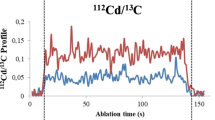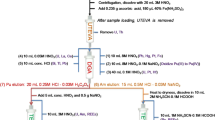Abstract
The use of environmental monitoring as a technique to identify activities related to the nuclear fuel cycle has been proposed by international organizations as an additional measure to the safeguards agreements currently in force. The specific element for each kind of nuclear activity, or ‘nuclear signature’, inserted into the ecosystem by several transfer paths, can be intercepted to a greater or lesser degree by different living organisms. This work demonstrates the technical viability of using pine needles as bioindicators for some nuclear signatures (Co, Ni, La, Ce, Sm, Th, and U) associated with uranium enrichment activities using high resolution inductively coupled plasma mass spectrometry (HR-ICP-MS). The concentrations of the elements whose signatures were sought and were determined in pine needle samples collected at five specific sampling locations inside the area investigated demonstrate the potential of the instrument and of the method used to identify and quantify the sought signatures present in low quantities (traces) in the evaluated matrix.
Similar content being viewed by others
References
W. L. Belew, J. A. Carter, D. H. Smith, R. L. Walker, Detection of Uranium Enrichment Activities using Environmental Monitoring Techniques, Martin Marietta Energy Systems, Inc., Oak Ridge, 1993.
D. L. Donohue, R. Zeisler, Anal. Chem., 65 (1993) 359.
B. Markert, V. Weckert, Sci. Total Environ., 86 (1989) 289.
B. Markert, Toxicol. Environ. Chem., 40 (1993) 43.
P. Anderson, C. M. Davidson, D. Littlejohn, A. M. Ure, C. A. Shand, M. V. Cheschire, Anal. Chim. Acta, 327 (1996) 53.
L. Svoboda, K. ZimmermannovÁ, P. Kalac, Sci. Total Environ., 246 (2000) 61.
K. W. Nicholson, C. L. Rose, J. A. Garland, W. A. McKay, I. R. Pomeroy, Environmental Sampling for Detection of Undeclared Nuclear Activities (SRDP R217), AEA Technology Consultancy Services, Oxfordshire, Feb. 1994.
E. Kuhn, R. Hooper, D. Donohue, Intern. Symp. on Environmental Impact of Radioactive Releases, IAEA, Vienna, May 1995, p. 35.
A. C. Zook, L. H. Collins, Application of a Direct Method for the Determination of Trace Uranium in Safeguards Samples by Pulsed Laser Fluorimetry, U. S. Department of Energy, NBL, Argonne, 1980.
A. Ghods-Esphahani, J. C. Veselsky, E. Zepeda, M. A. R. K. Peiris, Radiochim. Acta, 50 (1990) 155.
C. N. Machado Jr., S. P. Maria, M. Saiki, A. M. G. Figueiredo., J. Radioanal. Nucl. Chem., 233 (1998) 59.
B. Mazzilli, I. M. C. Camargo, J. Radioanal. Nucl. Chem., 212 (1996) 251.
J. S. Becker, H. J. Dietze, Anal. At. Spectrom., 12 (1997) 881.
J. S. Alvarado, T. J. Neal, L. L. Smith, M. D. Erickson, Anal. Chim. Acta, 322 (1996) 11.
B. Markert, Instrumental Element and Multi Element Analysis of Plant Samples: Methods and Applications, John Wiley, New York, N.Y., 1996.
M. H. Ramsey, A. Argyraki, M. Thompson, Analyst, 120 (1995) 2309.
American Society for Metals, Metals Handbook, Vol. 1, 9th ed., 1978, p. 447.
M. F. Campos, F. J. G. Landgraf, On the microstructure of SmCo5 magnets, in: 14th Intern. Workshop in Rare-Earth Magnets and their Applications, São Paulo, Brasil, September 1996, p. 338.
S. Giurlani, Brasil Nuclear, 16 (1998) 8.
J. Becker, H. Dietze, J. Anal. At. Spectrom., 12 (1995) 881.
G. Erikson, S. Jenson, H. Kylin, W. Strachan, Nature, 341 (1989) 42.
J. H. Buchmann, J. E. S. Sarkis, C. Rodrigues, Sci. Total Environ., 263 (2000) 221.
J. H. Buchmann, D. Thesis, IPEN, Brasil, 2000.
International Organization for Standardization, International Vocabulary of Basic and General Terms in Metrology, 2nd ed., Geneva, Switzerland, 1993.
IUPAC, in: Pure Appl. Chem., 70 (1998) 993.
J. H. Buchmann, J. E. S. Sarkis, Quim. Nova, 25 (2002) No. 1, 111.
National Institute of Standards and Technology NIST, Certificate of Analysis, Standard Reference Material 1575, Pine Needles, USA, 1993.
D. H. Smith, Oak Ridge National Laboratory Standard Operation Procedure (CASD-AM-TRL-0001), October 21, 1998.
Author information
Authors and Affiliations
Rights and permissions
About this article
Cite this article
Buchmann, J.H., Sarkis, J.E.S. & Rodrigues, C. Environmental monitoring used to identify nuclear signatures. Journal of Radioanalytical and Nuclear Chemistry 258, 139–142 (2003). https://doi.org/10.1023/A:1026274529301
Issue Date:
DOI: https://doi.org/10.1023/A:1026274529301




